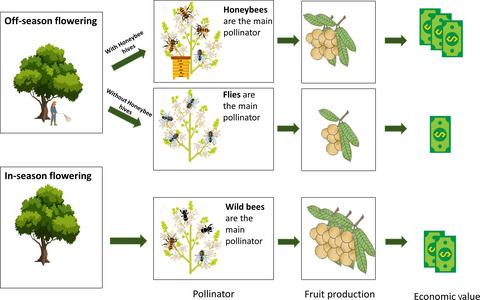当前位置:
X-MOL 学术
›
J. Appl. Ecol.
›
论文详情
Our official English website, www.x-mol.net, welcomes your
feedback! (Note: you will need to create a separate account there.)
Insufficient native pollinators during artificially induced early flowering decrease yield and long‐term economic viability of a tropical fruit crop
Journal of Applied Ecology ( IF 5.0 ) Pub Date : 2020-10-29 , DOI: 10.1111/1365-2664.13787 Tuanjit Sritongchuay 1, 2, 3 , Kanuengnit Wayo 4 , Michael C. Orr 5 , Alice C. Hughes 1, 2, 3, 6
中文翻译:

人工诱导的早花期间本地授粉媒介不足,降低了热带水果作物的产量和长期经济活力
更新日期:2021-01-07
Journal of Applied Ecology ( IF 5.0 ) Pub Date : 2020-10-29 , DOI: 10.1111/1365-2664.13787 Tuanjit Sritongchuay 1, 2, 3 , Kanuengnit Wayo 4 , Michael C. Orr 5 , Alice C. Hughes 1, 2, 3, 6
Affiliation

|
- The management of crops outside the regular cropping calendar can improve profits when supply is low and prices are high, but we do not know how induced, early flowering impacts the pollination services that crops require.
- This study examines the effects of flowering time and pollinator management, including managed honeybee colonies and ground flower cover, on the pollination of the tropical fruit tree, longan (Dimocarpus longan Lour.), comparing between in‐season flowering (naturally) and off‐season flowering (chemically induced) in Northern Thailand.
- Visitation rates of flower visitor groups significantly differed among treatments: for in‐season flowering, wild bees were the most frequent pollinator group, whereas in the off‐season flowering, there were no wild bees, and instead dipterans were the most frequent pollinator group. Some off‐season plantations have honeybee hives present and in this situation honeybees were the most frequent pollinator group.
- We show that temporal variation in the pollinator community significantly alters the pollination efficiency of longan crops. Consequently, longan production from off‐season longan farms generates lower net profit in the absence of managed bees and wild bees, and wild bees produced higher seed‐sets than either honeybees or dipterans.
- Synthesis and applications. Wild bees were the main pollinator group of longan in the in‐season flowering resulting in high fruit production; whereas in the off‐season flowering honeybees and dipterans were the main pollinator group. Longan production from off‐season longan farms without managed bee produced less net profit. The farmers practicing off‐season with honeybee hives management gain the largest net profit. Developing mechanisms to promote and maintain pollinator abundance and diversity is likely to increase the resilience of the system in addition to profit in the long term; thus, efforts should be made to provide more nesting habitat and reduce pesticide use.
中文翻译:

人工诱导的早花期间本地授粉媒介不足,降低了热带水果作物的产量和长期经济活力
- 在供应不足和价格高涨的情况下,常规播种日历之外的作物管理可以提高利润,但我们不知道早熟对花粉授粉服务的影响。
- 这项研究研究了开花时间和授粉媒介管理(包括管理的蜜蜂群落和地面花覆盖)对热带果树桂圆(Dimocarpus longan Lour。)授粉的影响,比较了季节内开花(自然)和异地开花的影响。泰国北部的季节开花(化学诱导)。
- 花访客组的访视率在不同处理之间有显着差异:就季节开花而言,野生蜜蜂是最常见的传粉媒介群,而在淡季开花中,没有野生蜜蜂,而二倍体则是最常见的传粉媒介群。一些淡季种植园中有蜜蜂蜂箱,在这种情况下,蜜蜂是最常见的授粉媒介。
- 我们表明授粉媒介社区的时间变化显着改变了龙眼作物的授粉效率。因此,在没有管理蜜蜂和野生蜜蜂的情况下,淡季龙眼养殖场生产的龙眼产生的净利润较低,并且野生蜜蜂的结实种子的繁殖率高于蜜蜂或二倍体。
- 综合与应用。野蜂是季节开花中龙眼的主要授粉媒介,导致果实高产。而在淡季,开花的蜜蜂和双翅类昆虫是主要的传粉媒介。淡季龙眼养殖场中没有管理蜜蜂的龙眼产量产生的净利润较少。淡季使用蜂箱管理的农民获得最大的净利润。建立促进和维持传粉媒介丰度和多样性的机制,从长远来看,除了可以提高利润外,还可能提高系统的适应能力;因此,应努力提供更多的筑巢栖息地并减少农药的使用。











































 京公网安备 11010802027423号
京公网安备 11010802027423号